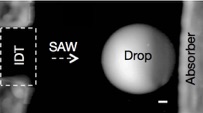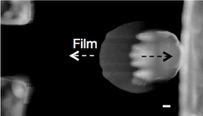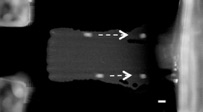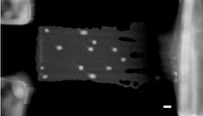Surface Acoustic Wave Film Formation and Droplet Actuation

The leakage of the acoustic energy into the fluid due to the diffraction of the surface acoustic wave front as it meets the fluid is responsible for the flow dynamics that arise, known as acoustic streaming. Over length scales much larger than the sound wavelength in the fluid, the viscous dissipation of the sound energy gives rise to a steady momentum flux which drives Eckart streaming. If the transfer of momentum to the interface arising from this together with the acoustic radiation pressure is sufficient to overcome the contact line forces that pin a sessile drop in position, the drop begins to translate. Such translation at linear speeds typically on the order of 1-10 cm/s together with the ability to split and merge them can be used in for drop actuation and bioparticle collection and concentration in open (droplet) microfluidic platforms for a variety of applications, such as chip-based polymerase chain reaction, biosensors, etc., in which the drop constitutes a transport vehicle for biological entities. We have also demonstrated this as novel mechanism for driving a drop containing a suspension of cells into a bioscaffold as a means for rapid and efficient bioscaffold cell seeding in tissue or orthopaedic engineering.
In addition, the elliptical retrograde motion of solid elements on the substrate as the SAW traverses underneath the drop also induces a steady drift flow within and at the edge of a submicron thick viscous boundary layer, known as Schlichting and Rayleigh streaming, respectively. Such flows have been observed to give rise to curious phenomena in which a counterpropagating thin film is pulled out from a sessile drop, whose front subsequently suffers from transverse instabilities to give rise to unique fingering patterns akin to, but quite distinct from, the classical viscous fingering instabilities observed in gravitational- and Marangoni-driven spreading films. Above these fingers, solitary wave pulses are seen to grow and translate away in the opposite direction.
-
1.MK Tan, JR Friend, LY Yeo. Microparticle Collection and Concentration via a Miniature Surface Acoustic Wave Device. Lab Chip 7, 618-625 (2007) (PDF).
-
2.H Li, JR Friend, LY Yeo. A Scaffold Cell Seeding Method Driven by Surface Acoustic Waves. Biomaterials 28, 4098-4104 (2007) (PDF).
-
3.H Li, J Friend, L Yeo, A Dasvarma, K Traianedes. Effect of Surface Acoustic Waves on the Viability, Proliferation and Differentiation of Primary Osteoblast-Like Cells. Biomicrofluidics 3, 034102 (2009) (PDF).
-
4.M Bok, H Li, LY Yeo, JR Friend. The Dynamics of Surface Acoustic Wave Driven Scaffold Cell Seeding. Biotechnol Bioeng, 103, 387-401 (2009) (PDF).
-
5.O Manor, M Dentry, JR Friend, LY Yeo. Substrate Dependent Drop Deformation and Wetting Under High Frequency Vibration. Soft Matter 7, 7976–7979 (2011) (PDF).
-
6.O Manor, LY Yeo, JR Friend. The Appearance of Boundary Layers and Drift Flows Due to High-Frequency Surface Waves. J Fluid Mech 707, 482–495 (2012) (PDF).
-
7.AR Rezk, O Manor, JR Friend, LY Yeo. Complex Acoustowetting Phenomena Involving Film Spreading, Fingering Instabilities and Soliton-Like Wave Propagation. Nature Commun 3, 1167 (2012) (PDF).
-
8.AR Rezk, O Manor, LY Yeo, JR Friend. Double Flow Reversal in Thin Liquid Films Driven by MegaHertz-Order Surface Vibration. Proc R Soc A 470, 20130765 (2014) (PDF) [Article coverart selected for journal front cover].
-
9.S Collignon, J Friend, L Yeo. Planar Microfluidic Drop Splitting and Merging. Lab Chip 15, 1942–1951 (2015) (PDF).
-
10.O Manor, AR Rezk, JR Friend, LY Yeo. Dynamics of Liquid Films Exposed to High-Frequency Surface Vibration. Phys Rev E 91, 053015 (2015) (PDF).






